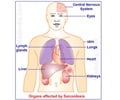Highlights
- Idiopathic pulmonary fibrosis is a condition that leads to a dramatic decrease in lifespan. Currently, there is no effective treatment for the condition.
- Lung tissue of people with this condition shows increased accumulation of certain cells called senescent cells.
- These cells secrete toxic molecules that affect the healthy cells, trigger inflammation and aberrant tissue remodelling .
- Senescent cells are also known to contribute to aging and aging-related conditions.
There is no cure for the condition. Current treatment methods aim to offer relief from symptoms and improve quality of life.
The prevalence of idiopathic pulmonary fibrosis increased from 13.4 cases per 100 000 persons in 2005 to 18.2 cases in 2010 per 100 000 persons in the U.S. The annual incidence of IPF decreased from 7.9 cases per 100 000 person-years in 2005 to 5.8 cases in 2010 per 100 000 person-years.
"Idiopathic pulmonary fibrosis is a poorly understood disease, and its effects are devastating," says Nathan LeBrasseur, Ph.D., director, Healthy Aging and Independent Living program, Mayo Clinic Robert and Arlene Kogod Center on Aging and senior author of this study.
"Individuals with idiopathic pulmonary fibrosis express difficulty completing routine activities. There are currently no effective treatment options, and the disease leads to a dramatic decrease in health span and life span, with life expectancy after diagnosis between three to five years." LeBrasseur added.
The research team included Dr. LeBrasseur and other experts across several departments at Mayo Clinic, as well as Newcastle University Institute for Aging and The Scripps Research Institute.
Researchers found the number of cells called senescent cells, were high and their burden increased with disease progression. They also found that the markers of cellular senescence, a process triggered by damage to cells and linked to aging, were higher in individuals with idiopathic pulmonary fibrosis.
The researchers also demonstrated that factors secreted by senescent cells could trigger inflammation and aberrant tissue remodeling and fibrosis. These are the characteristics of idiopathic pulmonary fibrosis.
"We discovered that senescent cells, which accumulate in the idiopathic pulmonary fibrosis lung, are a viable source of multiple factors that drive fibrotic activation," explains Marissa Schafer, Ph.D., a postdoctoral fellow in Dr. LeBrasseur's lab and lead author of the study.
According to Dr. LeBrasseur, the findings represent a conceptual shift in the way they think about idiopathic pulmonary fibrosis. "Up to this point, research efforts have largely focused on understanding the unique elements that contribute to idiopathic pulmonary fibrosis. Here, we are considering whether the biology of aging is accelerated in this aggressive disease. What we've found is that senescent cells are prevalent, secreting toxic molecules that affect healthy cells in that environment and are essentially promoting tissue fibrosis."
Replicating the Process in Mice
The research team replicated the process in mice and found that, much like in humans, the number of senescent cells were higher in mice with clinical features of idiopathic pulmonary fibrosis. Self-destruction of senescent cells was done using genetically modeled programs and a drug combination of dasatinib and quercetin which, in previous studies conducted by Mayo Clinic, was shown to eliminate senescent cells.
Results showed that clearing senescent cells from unhealthy mice improved measures of lung function and physical health, such as exercise capacity on a treadmill.
"Previous work from the Center on Aging has shown in a number of models how senescent cells contribute to aging and aging-related conditions," says Dr. LeBrasseur. "We are exploring whether senolytic drugs, or drugs that can selectively kill senescent cells, can be used for the treatment of aging-associated conditions, including idiopathic pulmonary fibrosis. More research is needed to validate this, and our goal is to move quickly from discovery to translation to application, and, ultimately, meet the unmet needs of our patients."
The findings appear in Nature Communications.
References
- Incidence and prevalence of idiopathic pulmonary fibrosis in US adults 18-64 years old. - (https://www.ncbi.nlm.nih.gov/pubmed/27126689)
- Idiopathic pulmonary fibrosis - (https://medlineplus.gov/ency/article/000069.htm)
- Nathan LeBrasseur et al.Nature Communications; (2017)
Source-Medindia














